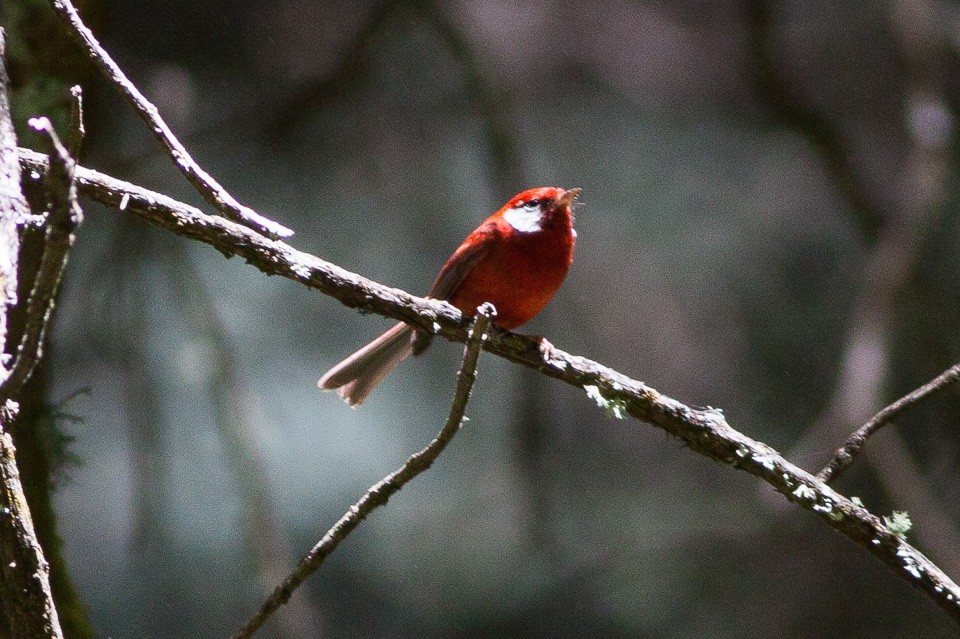Red Warbler
A species of Red-faced Warblers Scientific name : Cardellina rubra Genus : Red-faced Warblers
Red Warbler, A species of Red-faced Warblers
Botanical name: Cardellina rubra
Genus: Red-faced Warblers
Content
Description General Info
Description
The red warbler is a small passerine, measuring 12.5–13.5 cm (4.9–5.3 in) in length, and weighing from 7.6 to 8.7 g (0.27 to 0.31 oz). As an adult, it is red overall, with either a white or dark gray (depending on the subspecies) auricular patch on each side of its head. Its wings and tail are slightly darker, dusky red, and edged in pinkish-red. Its legs are a dull red-brown, and its thin bill is pinkish-gray with a dark tip. The iris is dark brown to blackish. Plumage varies little between the sexes, although the female tends to be a little duller or more orange-tinged. Adult pairs separate and moult fully from August, after the breeding season. The adult red warbler is hard to confuse with any other bird species in its range; the scarlet tanager and summer tanager have similar mostly-red plumage but are larger with thick conical bills. As a juvenile, the red warbler is pinkish-brown with a whitish auricular patch. Its darker wings and tail show pinkish-cinnamon edges, with two paler wingbars on the former. 
Size
13 cm
Nest Placement
Shrub
Feeding Habits
Red Warbler, primarily insectivorous, consumes various insects especially Neuroptera. Exhibits foraging behavior, typically in understory vegetation. No unique dietary adaptations noted.
Habitat
Red Warbler's habitat predominantly comprises high elevation coniferous forests, including regions dense with pine, fir, and pine-oak woodlands. During off-breeding periods, red Warbler adapts to oak-dominated forests. Generally, this species favors cooler, moist montane environments across broad geographical regions rather than specific locales.
Dite type
Insectivorous
General Info
Feeding Habits
Bird food type
Sounds
Call
Recording location: Mexico
Song
Recording location: Mexico
Song
Recording location: Mexico
Behavior
Though it occasionally joins mixed-species flocks, the red warbler is more typically found alone or in pairs. Youngsters probably choose mates in the autumn of their first year, and pairs remain together year-round, except during severe weather and during post-breeding molt. 
Distribution Area
Endemic to the highlands of Mexico north of the Isthmus of Tehuantepec, the red warbler has three disjunct populations that correspond to the three subspecies: from southwestern Chihuahua to northern Nayarit, from southern Jalisco and southern Hidalgo to Oaxaca, and from Guerrero into southern Oaxaca in the Sierra Madre del Sur. It is fairly common to common in the country's interior and on adjacent slopes, where it occurs at elevations ranging from 1,800 to 3,900 metres (5,900 to 12,800 ft) above sea level; it does not occur along either coast. It is an altitudinal migrant, moving from higher humid or semi-humid pine, pine-oak and fir forests in the breeding season to lower elevations, often in oak forests, in the winter. It is among the most common of the small birds in its woodland habitat, second only to the golden-crowned kinglet in fir forests in one study and the third most common warbler in oak-conifer woodlands in another. Though the species was reported to have been collected in Texas in the late 19th century, the record's location was not widely believed, and there is no strong evidence that it ever occurred there. It has strayed as far north as southeastern Arizona, where a bird was found on Mount Lemmon in 2018. 
Species Status
The red warbler is currently rated as a species of least concern by the International Union for the Conservation of Nature. Though there is evidence that its numbers are decreasing, the decline has not been precipitous (that is, under a 30% decline over ten years or three generations), and the population remains quite large, estimates ranging from 50,000 to 499,999 birds. The forested areas in which it occurs include some of the most threatened habitats in Mexico; logging, agricultural expansion, firewood gathering, road building, tourist development, overgrazing and intensive urbanization are among the many things contributing to the destruction of the forests. There is some evidence that selective logging in pine forests may actually favor this species, which prefers more open, sunlit areas in which to breed. 
Scientific Classification
Phylum
Chordates Class
Birds Order
Perching birds Family
New world warblers Genus
Red-faced Warblers Species
Red Warbler 